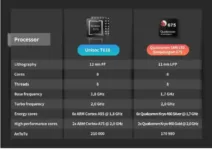The trend of mobile phone processors is becoming smaller, faster, and more effective with the development of technology and science. AI and multimedia technology have enabled these processors to conduct an intelligent classification of photos, scene recognition, face unlocking, AI photo retouching, and video. Nowadays, we may not realize that an effective chipset changes our life thoroughly.
T618 has overtaken rivals in many aspects. Take Snapdragon 675, for example. Even though it seems that in the aspect of the lithography, UNISOC T618 slightly has laid behind the Snapdragon 675, UNISOC T618 uses a 12nm process (Snapdragon 675 11nm), but on the other side, UNISOC T618 has achieved the balance between performance and power consumption.
It can be illustrated from two perspectives: firstly, regarding AnTuTu Benchmark (a benchmarking tool for Android smartphones and tablets that helps check the performance of devices), T618 gets a score of 21,0000, whereas Snapdragon 675 only gets a 170980 score. Secondly, both chipsets are octa-core, but the T618 CPU has a base frequency of 1.8GHz and a maximum of 2.0GHz, while the Snapdragon 675 has a base frequency of 1.7 GHz.
In terms of camera, Snapdragon can support a Quad HD (2560×1600 pixel) display. It also provides an option of 4K output to an external display. The max display resolution of UNISOC T618 is 2400* 1080. In terms of imaging, Snapdragon can support Dual 14-bit ISPS and dual cameras with MFNE and ZSL at 30fps (up to 16MP), a single camera (up to 48Mp) with MFNR and ZSL, 30fps, up to 25 MP. On the other hand, UNISOC T618 has also upgraded greatly, supporting 48MP lens and 25fps video, or 32MP lens and 30fps video, cphy supports up to 2.5Gsps.
UNISOC T618 has done its homework on performance balance and user experience. First, in terms of game performance improvement, the game performance is strong. It can run large games without losing frames. The high frame rate of 120 is almost the same as that of Snapdragon 870, which makes the effect of running large 3D games better. Second, UNISOC T618 has been greatly upgraded in terms of influencing the ability to support 48 MP lens and 25fps video, or 32 MP lens and 30fps video, C-PHY supports up to 2.5GSPs. With the help of AI, the impact capability is further improved. Third, the powerful AI capability. Compared with other mid-range processors, UNISOC T618 also has an additional visual information processor (VDSP), which can better meet the needs of edge vision and AI processing, and supports photo gallery intelligent classification, scene recognition, face unlocking, AI beauty photo and video, AI portrait background blur photo and recording, AI image retouching and other functions. In HDR, real-time beauty, semantic segmentation, and other applications, the performance has been better improved. Fourth, in terms of information security, UNISOC T618 has a unique password engine, which can achieve security isolation, key self-destruction, and other functions. It also supports the mainstream domestic plus decryption algorithm, a series of encryption, to ensure a high degree of security. At present, it has been successfully commercialized by famous terminal manufacturers at home and abroad, such as Teclast, ZTE, and Cube.








